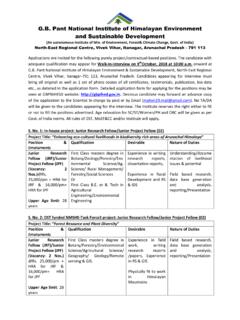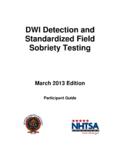Transcription of CONSUMPTION OF THE SEWING THREAD OF JEAN PANT …
1 CONSUMPTION OF THE SEWING THREAD OF JEAN PANT using taguchi design ANALYSISB. Jaouachi1, F. Khedher1, F. Mili2 1 Laboratory of Engineering Textile of Ksar Hellal, University of Monastir, Tunisia2 National Engineering School of Monastir, University of Monastir, TunisiaIntroductionKnowing the amount of yarn required for SEWING a garment thereby enabling a reliable estimation of the garment cost and raw material required, helps industrial producers to minimize their THREAD CONSUMPTION during SEWING of cloths. CONSUMPTION of SEWING THREAD is a complex textile, especially, clothing research subject.
2 Many studies are conducted to evaluate some clothing problems such as recovery, bagging, physico-mechanical behaviours, etc. [1-3]. However, concerning THREAD CONSUMPTION , comparatively little investigative work has taken place on the interrelationship between the SEWING machine parameters, the THREAD insertion inputs and clothing morphology. Relative motion of the fabric plies being stitched affects the prediction of the THREAD CONSUMPTION because it is highly complex to fix it as a function of all influential parameters. To measure the THREAD CONSUMPTION , accessed by unpicking the seam using such techniques, some input parameters are investigated such as the stitch length, THREAD tension and its compressive modulus [4].
3 Dorrity and Olson studied the THREAD motion and they developed a prototype system for detecting SEWING defects. Research results show that the system yields reliable indication of THREAD CONSUMPTION -related faults, such as broken top or bobbin threads, misfed fabric, and THREAD tension imbalance, for several stitch types [6]. Moreover, the effects of check-spring travel and the feed retardation on lockstitch SEWING which affects intuitively the THREAD CONSUMPTION have been analyzed by Hayes and Kennon [7,8]. ExperimentalThere are a number of different types of seaming that have been developed to different SEWING applications [9].
4 When we make the assemblage with such machines (Figure 1, a, b and c), , flat felled seam (2 x 401), safety stitch machine (ISO 516), and lockstitch machine (301), each machine releases a normalized stitch according to the norm ISO 4915:1991 norm [10]. We will study their effect on the THREAD CONSUMPTION . All adjustment conditions are regulated to obtain good quality of assembly. Table 1 shows the THREAD type characteristics. Abstract:This work deals with the evaluation of SEWING THREAD CONSUMPTION in jeans and classic pants clothing.
5 Six different input parameters are chosen and used for investigation. To objectively evaluate their contributions, a taguchi design analysis was applied. Based on the comparison between each input parameter effect, this experimental analysis helped us to classify the overall tested factors. Indeed, our findings show that the SEWING yarn affects widely the THREAD CONSUMPTION during stitching of the pant. In spite of their non negligible impact, the number of stitches per cm and the needle type can be considered as influential input factors on THREAD CONSUMPTION . In our experimental design the other tested factors were kept : CONSUMPTION , pant clothing, SEWING THREAD , taguchi designFigure 1.
6 Different SEWING stitchs: a. Assembly with lockstitch machine (type of stitch: 301) b. Assembly with felled seam machine (type of stitch: 2x401) c. Assembly with safety stitch machine (type of stitch: 516) Research Journal, Vol. 12, No 4, December 2012, DOI: AUTEX 81the level value is equal to 1, then it is considered the lowest level. However, if the level value is equal to 2 then it is the highest one. This is available when the input factor presents two levels only. Each factor or parameter has levels which define our experimental field of interest limits.
7 Table 2 shows the tested input parameters, their fixed adjustments and their correspondent levels which would help us in preparing our specimens. Juki lockstitch and overlockstitch machine parameters were adjusted to the manufacturer s recommended standard determine the input level values, numeric or text values for each level of the factor should be entered. By default, Minitab sets the levels of a factor to the integers 1, 2, 3, 4, 5 .. as a function of the input adjustment regulations. If the input factor has 3 or 4, 5, 6 6.
8 Levels, adjustment regulations values, then these levels should be indexed by 3, 4, 5, 6, Hence, by default, Minitab s orthogonal array designs use the integers 1, 2, to represent factor levels. If factor levels were entered, the integers 1, 2, 3, .., would have been the coded levels for the design . Indeed, a taguchi design is chosen, because it represents a method of designing experiments that usually requires only a fraction of the full factorial combinations. Besides, an orthogonal array means the design is balanced so that factor levels are weighted equally.
9 Due of this, each input parameter can Hence, two different threads are used to compare their effects as well as the other input parameters on the SEWING THREAD CONSUMPTION of pants (Figure 2). In addition, to compare the contribution of the type of SEWING machine on the evaluation of THREAD consumptions of each jean pant, we choose two kinds of machine: within and without automatic THREAD trimmer. To objectively evaluate and analyse the overall contributions, a taguchi experimental design -type was elaborated. Six different inputs, SEWING machine type, SMT, stitch length, SL, THREAD count, Tc , needle count, Nc , fabric composition, Fc and mass, M, are investigated.
10 Therefore, a taguchi experimental design can help us to classify objectively the input parameter contributions on the THREAD CONSUMPTION values. Indeed, when CharacteristicsThread 1 THREAD 2 Composition100%PES100%CottonNatureTwiste d 2 endsTwisted 3 endsYarn/ THREAD count (tex)16,516,67 Twist directionZZTable 1. SEWING threads type characteristics. Input levelSewing machine type, SMTS titch length, SL (mm) THREAD composition, Tc Needle count, Nc Fabric composition, FcMass, M (g/mm2)1 Without automatic THREAD trimmer2,22100% PES120100% Cotton2682 Within automatic THREAD trimmer2,85100%Cotton90 Stretch:98% Cotton + 2% Elastane417 Table 2.








